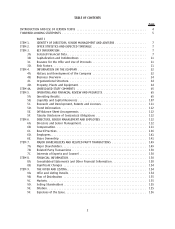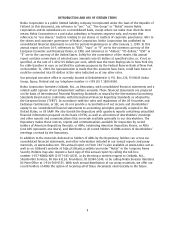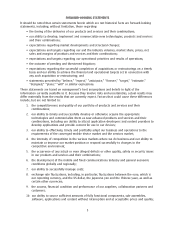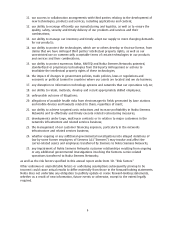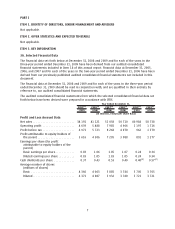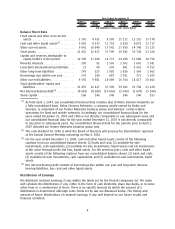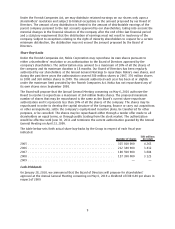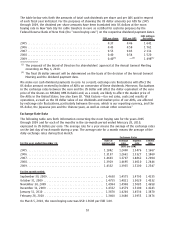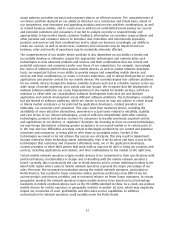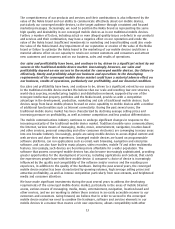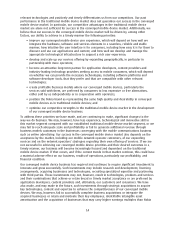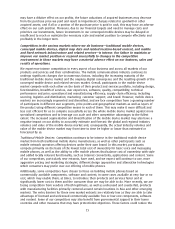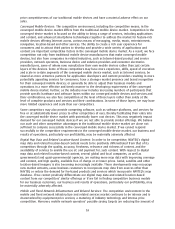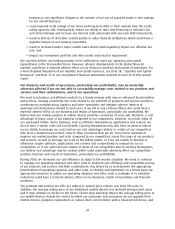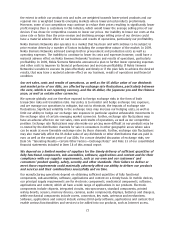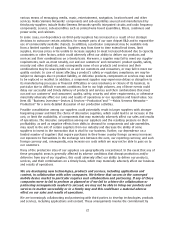Nokia 2009 Annual Report Download - page 14
Download and view the complete annual report
Please find page 14 of the 2009 Nokia annual report below. You can navigate through the pages in the report by either clicking on the pages listed below, or by using the keyword search tool below to find specific information within the annual report.usage patterns and other personal and consumer data in an efficient manner. The competitiveness of
our device portfolio depends on our ability to introduce on a continuous and timely basis, ahead of
our competitors, new innovative and appealing products and services and their combinations, as well
as related business models, and to create new or address yet unidentified needs among our current
and potential customers and consumers. If we fail to analyze correctly or respond timely and
appropriately to key market trends, customer feedback, information on consumer usage patterns and
other personal and consumer data or to introduce new innovative and commercially appealing
products and services and their combinations and to adapt our business accordingly, our ability to
retain our current, as well as attract new, customers and consumers may be impaired and our
business, sales and results of operations may be materially adversely affected.
The competitiveness of our mobile device portfolio is also dependent on our ability to timely and
successfully develop or otherwise acquire the appropriate technologies and commercialize such
technologies as new advanced products and services and their combinations that our current and
potential customers and consumers prefer over those of our competitors. For example, increasingly
the choice of software platform that powers mobile devices, as well as related software developer
tools, are important factors in our ability to provide unique and compelling mobile devices and
services and their combinations, to create a rich user experience, and to attract third parties to create
applications and provide content for our mobile devices. We currently deploy four software platforms
for our mobile devices designed to balance usability, features and cost in a flexible manner across our
wide range of market segments, price points and user groups. We recognize that the deployment of
multiple software platforms can create fragmentation in the market for mobile services, which we
endeavor to offset with our crossplatform software development tools that run and facilitate
application and content development across different software platforms. The technologies, including
but not limited to software platforms, which we choose to focus on may not achieve or retain broad
or timely market acceptance or be preferred by application developers, content providers and,
ultimately, our customers and consumers. This may result from numerous factors, including the
availability of more attractive alternatives; perceived or actual issues related to reliability, stability
and ease of use of our chosen technologies; a lack of sufficient compatibility with other existing
technologies, products and services; barriers for consumers to transfer previously acquired content
and applications to our devices; or regulators’ decisions. By choosing to focus on certain technologies,
we may forego alternatives achieving greater acceptance in our overall market or in certain parts of
it. We may also face difficulties accessing certain technologies preferred by our current and potential
customers and consumers, or being able to offer those at acceptable prices. Further, if the
technologies we invest in do not achieve the success we anticipate, this may result in impairment
charges related to those technology assets. Additionally, even if we do select and have access to the
technologies that customers and consumers ultimately want, we or the application developers,
content providers or other third parties that work with us may not be able to bring our products and
services, including applications and content, and their combinations to the market at the right time.
Certain mobile network operators require mobile devices to be customized to their specifications with
preferred features, functionalities or design and cobranding with the mobile network operator’s
brand. Currently, this is particularly the case in North America and in certain individual markets in the
AsiaPacific region where sales to mobile network operators represent the major percentage of our
sales. Moreover, the increased concentration among the mobile network operators, particularly in
North America, has resulted in fewer customers whose purchase preferences may differ from our
current product and services portfolio, and in increased reliance on fewer larger customers. In certain
geographic markets the network operators require mobile devices to be based on local technology
standards in mobile communications, such as the TDSCDMA standard in China. As a result, we produce
mobile devices for certain operators or geographic markets in smaller lot sizes, which may negatively
impact our economies of scale, profitability and aftersales service capabilities. In addition,
customization for network operators could possibly erode the Nokia brand.
12


